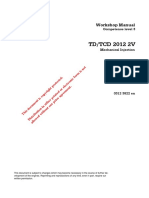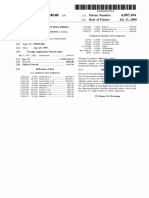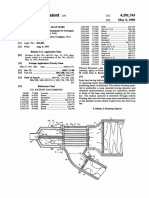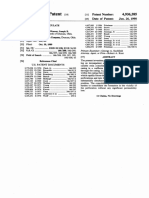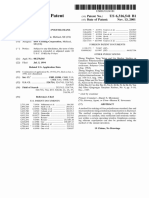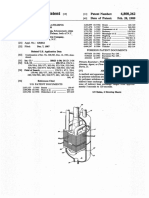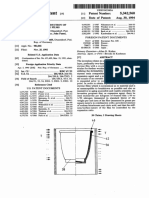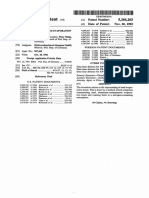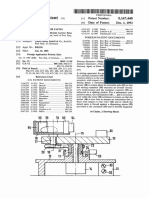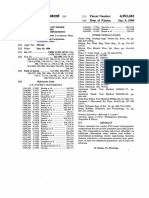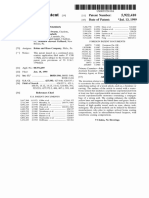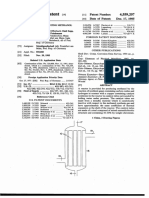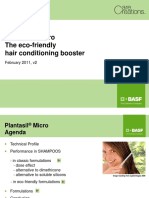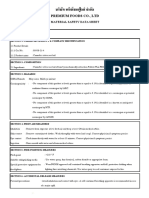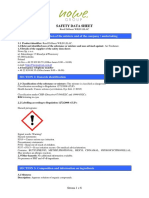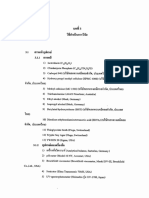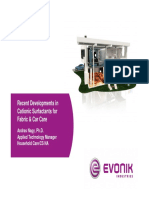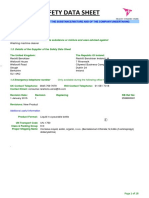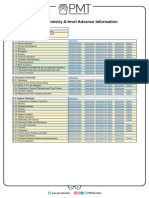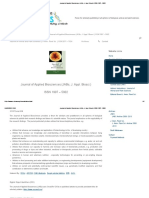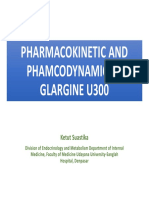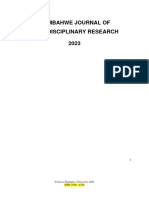0 ratings0% found this document useful (0 votes)
52 viewsUs 4597889
Us 4597889
Uploaded by
topguitarThis patent describes a stable, homogeneous laundry detergent slurry containing polymeric acrylic stabilizers. The slurry contains 14-30% sodium polyphosphate, 0-1% sodium carboxymethylcellulose, 0-5% inorganic alkali metal hydroxide or salt, 13-20% nonionic surfactant, and 0.4-2% of a high molecular weight polymer of an acrylic acid. The sodium polyphosphate is present partly as insoluble particles 1-10 microns in diameter, allowing more than the soluble amount to be included and preventing separation.
Copyright:
© All Rights Reserved
Available Formats
Download as PDF, TXT or read online from Scribd
Us 4597889
Us 4597889
Uploaded by
topguitar0 ratings0% found this document useful (0 votes)
52 views5 pagesThis patent describes a stable, homogeneous laundry detergent slurry containing polymeric acrylic stabilizers. The slurry contains 14-30% sodium polyphosphate, 0-1% sodium carboxymethylcellulose, 0-5% inorganic alkali metal hydroxide or salt, 13-20% nonionic surfactant, and 0.4-2% of a high molecular weight polymer of an acrylic acid. The sodium polyphosphate is present partly as insoluble particles 1-10 microns in diameter, allowing more than the soluble amount to be included and preventing separation.
Original Description:
patent
Copyright
© © All Rights Reserved
Available Formats
PDF, TXT or read online from Scribd
Share this document
Did you find this document useful?
Is this content inappropriate?
This patent describes a stable, homogeneous laundry detergent slurry containing polymeric acrylic stabilizers. The slurry contains 14-30% sodium polyphosphate, 0-1% sodium carboxymethylcellulose, 0-5% inorganic alkali metal hydroxide or salt, 13-20% nonionic surfactant, and 0.4-2% of a high molecular weight polymer of an acrylic acid. The sodium polyphosphate is present partly as insoluble particles 1-10 microns in diameter, allowing more than the soluble amount to be included and preventing separation.
Copyright:
© All Rights Reserved
Available Formats
Download as PDF, TXT or read online from Scribd
Download as pdf or txt
0 ratings0% found this document useful (0 votes)
52 views5 pagesUs 4597889
Us 4597889
Uploaded by
topguitarThis patent describes a stable, homogeneous laundry detergent slurry containing polymeric acrylic stabilizers. The slurry contains 14-30% sodium polyphosphate, 0-1% sodium carboxymethylcellulose, 0-5% inorganic alkali metal hydroxide or salt, 13-20% nonionic surfactant, and 0.4-2% of a high molecular weight polymer of an acrylic acid. The sodium polyphosphate is present partly as insoluble particles 1-10 microns in diameter, allowing more than the soluble amount to be included and preventing separation.
Copyright:
© All Rights Reserved
Available Formats
Download as PDF, TXT or read online from Scribd
Download as pdf or txt
You are on page 1of 5
United States Patent (19) 11 Patent Number: 4,597,889
Jones et al. 45 Date of Patent: Jul. 1, 1986
54) HOMOGENEOUS LAUNDRY DETERGENT 4, 175,062 11/1979 Disch et al. ......................... 252/540
SLURRIES CONTAINING POLYMERC 4,215,004 7/1980 Borgerding et al................. 252/156
ACRYLC STABILIZERS 4,228,048 10/1980 Tesdahl ............. ... 252/135
4,244,840 l/1981 Straw ... ... 252/540
(75) Inventors: Charles E. Jones, Yardley, Pa.; 4,252,665 2/1981 Casey ........ ... 252/06
Bette-Jean Brabant, Mercerville, 4,284,533 8/1981 Imamura ... ... 252/542
N.J. 4,302,347 1 1/1981 Straw et al. ... ... 252/116
(73) Assignee: FMC Corporation, Philadelphia, Pa. 4,325,829 4/1982 Duggleby............................ 252/109
4,379,080 4/1983 Murphy. ... 252/526
(21) Appl. No.: 645,588 4,404,115 9/1983 Tai ..... ... 252/135
4,446,043 5/1984 Tai....................................... 252/105
22 Filed: Aug. 30, 1984 4,462,922 7/1984 Boskamp ........................ 252/17412
(51) Int. Cl." ....................... C11D 3/075; C11D 3/37; 4,490,271 12/1984 Spadini........................... 252/174.23
C11D 17/08 FOREIGN PATENT DOCUMENTS
52) U.S. C. .................................... 252/135; 252/156; 623617 7/1961 Canada .
252/173; 252/174.14; 252/174.18; 252/174.21; 0038101 10/1981 European Pat. Off. .
252/174.24; 252/174.25; 252/DIG. 14 870994 6/1961 United Kingdom.
58) Field of Search ................... 252/135, 156, 174.14, 2028365 3/1980 United Kingdom.
252/174.24, 173, 174.18, DIG. 14, 540
Primary Examiner-Dennis L. Albrecht
(56) References Cited Attorney, Agent, or Firm-Frank Ianno; Eugene G.
U.S. PATENT DOCUMENTS Seems
2,798,053 7/1957 Brown ............................ 252/174.24 57 ABSTRACT
2,979,466 4/1961 Silberman ........................... 252/138 A stable, homogeneous, aqueous detergent slurry is
3,060,124 10/1962 Ginn ............ ... 252/135
3,133,024 5/1964 Feierstein .... ... 252/540 described containing polymeric acrylic stabilizers. The
3,231,504 1/1966 Marion et al. ... 252/137 slurry contains about 14 weight percent to about 30
3,254,028 5/1966 Wixon ...... ... 252/137 weight percent of a sodium polyphosphate, 0 to about 1
3,328,309 6/1967 Grifo ........ ... 252A135 weight percent of sodium carboxymethylcellulose, 0 to
3,350,319 10/1967 Schonfeldt ... 252/138 about 5 weight percent of a compatible inorganic alkali
3,509,059 4/1970 Renold .... ... 252/135
3,629,125 12/1971 Payne ...... ... 252/135 metal hydroxide or salt as a viscosity modifier, a soluble
3,639,288 2/1972 Kerkhoven. ... 252/.35 nonionic surface-active agent in amounts of from about
3,703,470 1 1/1972 Brennan ................................ 252/99 13 weight percent to about 20 weight percent, a stabiliz
3,720,621 3/1973 Smeets .... ... 252A135 ing amount ranging from about 0.4 to about 2 weight
3,740,352 6/1973 Sommers. ... 252A548 percent of a high molecular weight polymer of an
3,799,880 3/1974 Kelly........... ...
252/10 acrylic acid, and wherein said sodium polyphosphate is
3,922,230 1 1/1975 Lamberti..... ...
252/539
4,082,684 4/1978 Kreischer .... ... 252/109 present in part as insoluble particles having an average
4,097,405 6/1978 Watts .............. ... 252/316 diameter of about 1 to about 10 microns.
4,147,650 4/1979 Sabatelli et al. .... ... 252/103
4,153,569 5/1979 van den Brom .................... 252/109 13 Claims, No Drawings
1. 4,597,889
2
HOMOGENEOUS LAUNDRY DETERGENT localized, deeply embedded stains and dirt on any such
garments.
SLURRIES CONTAINING POLYMERICACRYLC One problem that has arisen in the use of these liquid
STABILIZERS detergent compositions is that popular builders such as
the sodium polyphosphates, and in particular sodium
The present invention relates to built laundry deter tripolyphosphate, have a limited solubility in the aque
gent compositions, and specifically to such composi ous composition on the order of about 14% by weight.
tions which are stable, homogeneous slurries. In the This figure may be decreased substantially because of
detergent art, it is known that laundry formulations the addition of other ingredients to the composition,
contain builders which enhance the cleaning ability of 10 notably the presence of certain surface-active agents.
the formulation. The most popular of these builders, This means that the amount of sodium tripolyphosphate
because of availability and cost, are sodium polyphos desired to be added to the liquid detergent composition
phates, of which sodium tripolyphosphate is the most would exceed its solubility and would result in a com
commonly used. position which no longer is a purely liquid detergent
The sodium polyphosphate builder, and particularly 15 composition. One way to overcome this problem is to
sodium tripolyphosphate, is known to function in laun use the potassium salt in place of the sodium salt of a
dry detergents in many ways to enhance the cleaning polyphosphate, such as potassium tripolyphosphate,
power of the detergents. For example, when dissolved which is much more soluble than its sodium equivalent,
in the aqueous medium in which clothes are being and can be put in large amounts without exceeding its
washed, it acts to sequester heavy metal ions thereby 20 solubility limits. Another technique is to use sodium
softening the water used for washing. The sodium tri tripolyphosphate in combination with large amounts of
polyphosphate functions cooperatively with the surfac soluble potassium salts, for example, potassium chlo
tants present in the detergent formulation to enhance ride, which also has the effect of solubilizing the sodium
the removal of oils and dirt particles from the garments 25 tripolyphosphate. Both of these techniques are unde
being washed and helps to maintain these removed oils sired because of the high cost of either potassium tri
and particles in suspension as a fine emulsion or dis polyphosphate or the potassium salts necessary to solu
persed particles in the wash water. Thus, the sodium bilize the sodium tripolyphosphate.
tripolyphosphate serves to increase the detergency Another approach to this problem is to employ so
function of the laundry formulation by maintaining the 30 dium tripolyphosphate in liquid detergents in excess of
removed oils and particles dispersed in suspension so its solubility to form slurries, and to utilize such pour
that they can be separated along with the wash water able slurries in the same way as a liquid detergent. This
from the garments being cleaned. approach gives rise to two requirements. The first is
The incorporation of sodium polyphosphates, such as that of keeping the undissolved sodium tripolyphos
sodium tripolyphosphate, in detergent compositions 35 phate in a homogeneous suspension in the detergent
presents no problem when these compositions are in slurry to insure uniform dispensing of the ingredients
solid form. Almost any amount of sodium tripolyphos gent regardless of which portion (first or last) of the deter
phate can be incorporated in solid detergent composi gent slurry is dispensed. The second is to keep the deter
slurry stable so that separation of the aqueous
tions, whether they be in form of the powders, granules
or tablets, since the sodium tripolyphosphate can be phase from the surface-active agents does not occur. In
general, substantial amounts of surface-active agents
made in bulk densities corresponding to the bulk density must be incorporated with the sodium tripolyphosphate
of the detergent composition. By this means, a homoge in order to secure optimum cleaning with the slurry
neous detergent composition is maintained regardless of formulation and there is a tendency to obtain separation
the amount of sodium tripolyphosphate employed. In of these two liquid phases when the desired large
deed, this is one of the reasons why such solid detergent amounts of surface-active
compositions have been so popular and still comprise 45 weight agents, that is, about 13
the bulk of the detergent formulations sold in the mar lation, is included in such detergentpercent
percent to about 20 weight of the formu
slurry composition.
ketplace.
It has now been found that a stable, homogeneous,
There is an increasing desire in the detergent industry aqueous
to employ liquid detergent compositions instead of their 50 polymeric detergent slurry can be formulated containing
solid counterparts because of the advantages the liquid acrylic stabilizers comprising:
a.
compositions possess when compared with the solid 14 weight percent a sodium polyphosphate in amounts of from about
formulations. The advantages of these liquid formula to about 30 weight percent,
b. sodium carboxymethylcellulose
tions include a positive means for mechanically dispens 0 weight percent to about 1 weight percent, in amounts of from
ing measured doses in automatic washing machines 55 c. a compatible, inorganic alkali metal hydroxide or
compared with the solid compositions which give rise alkali metal salt in amounts of 0 weight percent to about
to blockages or residue in delivery tubes. The liquid 5 weight percent as a viscosity modifier,
formulations also eliminate dusting which often accom
panies the measurement and dispensing of powdered totaling fromnonionic
d. soluble surface-active agents in amounts
laundry detergents. Caking of such powdered deter 60 weight percent,about 13 weight percent to about 20
gents is also encountered, which prevents proper dis e. a high molecular weight polymer of an acrylic
pensing. Another advantage is that the liquids are ho acid, in stabilizing amounts of from about 0.4 weight
mogeneous and there is no problem with segregation of percent to about 2 weight percent, and
different ingredients that may have different sizes or
specific gravities in the powdered laundry detergent. 65 insolublesodium
f, said
particles
polyphosphate being present in part as
having an average diameter of about
Still another advantage of the liquid detergent formula 1 to about 10 microns,
tions is that they can be applied directly to soiled areas
on the articles being cleaned to improve removal of to Inhave the formulation of the present slurry, it is desired
the undissolved sodium polyphosphate present
4,597,889
3 4
in the form of insoluble particles having an average intimately mix the subsequently added surface-active
diameter of about 1 to about 10 microns. This size is agents with the aqueous portion of the slurry in order to
desired to assure that any undissolved sodium polyphos obtain a slurry composition that is stable, so that separa
phate will remain in the formulation as a homogeneous tion of an aqueous phase from the surface-active agents
slurry that remains pourable. If the undissolved parti does not occur.
cles of sodium polyphosphate are too large, they will After mixing of the alkali metal salt or alkali metal
settle from the remainder of the formulation. If the hydroxide, CMC and sodium polyphosphate, the next
particles are too small, they will form a gel-like mass ingredient that is added, with high shear stirring, is one
that will not have the desired flow characteristics of a of the soluble nonionic surface-active agents described
pourable liquid. 10
herein. The preferred nonionic surface-active agents
A preferred method for producing the present slurry employed are alcohol alkoxylates, for example, alkyl
formulation is to first dissolve the viscosity modifier, phenol alkoxylates, and preferably alcohol ethoxylates
when this is desired for altering the final viscosity of the or alcohol propoxylates. However, the alcohol struc
formulation. Such modifier, namely, an alkali metal salt ture may vary considerably in chain length. For exam
or alkali metal hydroxide, is dissolved in amounts of 15
ple, surface-active agents such as Neodol (R) 91-2.5 is the
from 1 weight percent to about 5 weight percent, in the reaction product of a C9-C11 alcohol with an average of
requisite amount of water to form a solution containing 2.5 moles of a ethylene oxide to form a polyethoxylate.
an alkali metal ion, preferably sodium or potassium ion.
To this solution is added, prefereably, 0.1 weight per Other similar nonionic surface-active agents which can
cent to about 1 weight percent of sodium carboxy 20 be used include the following:
methylcellulose (CMC) with stirring until dissolved.
The addition of the CMC should precede addition of Surface-Active Agent Structure
any insoluble polyphosphates to the formulation. How Neodol (R) 23-6.5 C12-C13 alcohol ethoxylate
ever, the CMC can be added either prior to or after the (I mole C12-C3 alcohol to
addition of the alkali metal salt or hydroxide. 25
6.5 moles ethylene oxide)
The alkali metal salt or alkali metal hydroxide which Neodol (R) 91-6 C9-C11 alcohol ethoxylate
functions as a viscosity modifier, is used in amounts of (i mole C9-C alcohol to .
from about 1 weight percent to about 5 weight percent, 6 moles ethylene oxide)
octylphenyl ethoxylate (1
and preferably includes sodium carbonate, sodium hy Triton (R) X-100
mole of octylphenol to 10
"droxide, potassium chloride, sodium chloride potassium 30 moles of ethylene oxide)
carbonate, tetrapotassium pyrophosphate and potas Neodol (E) 25-7 C1-C5 alcohol ethoxylate
sium tripolyphosphate. Other alkali metal salts or hy (1 moie C12-C5 alcohol to
droxides include potassium hydroxide, potassium bicar 7 moles ethylene oxide)
bonate, sodium sesquicarbonate, potassium sesquicar Neodol (R) 25-9 C12-C15 alcohol ethoxylate
bonate, sodium borate, potassium borate, potassium 35 (1 mole C12-C15 alcohol to
9 moles ethylene oxide)
sulfate, sodium sulfate, sodium orthophosphate and Neodol (R) 45-13 C4-C15 alcohol ethoxylate
potassium orthophosphate. (I mole of C4-C5 alcohol
The desired sodium polyphosphate, and preferably to 13 moles ethylene oxide)
sodium tripolyphosphate, is then added in amounts of Neodol (R) 45-7 C4-C15 alcohol ethoxylate
about 14 weight percent to about 30 weight percent. 40 (1 mole of C4-C15 alcohol
to 7 moles of ethylene oxide)
The added sodium polyphosphate dissolves up to the
limit of its solubility and the remainder, which cannot
stay dissolved, recrystallizes from the aqueous solution It is possible to mix the above soluble, nonionic alco
to form insoluble particles having an average diameter hol alkoxylate surface-active agents, provided the total
of about 1 to about 10 microns. 45 amount of such agents is from about 13 weight percent
The sodium polyphosphate employed is preferably to about 20 weight percent of the slurry formulation
sodium tripolyphosphate but other polyphosphate mix The final required ingredient is a stabilizing amount
tures can be employed such a tetrasodium pyrophos of a high molecular weight polymer of an acrylic acid in
phate, and mixtures of sodium tripolyphosphate and amounts of from about 0.4 weight percent to about 2
tetrasodium pyrophosphate. When sodium tripolyphos 50 weight percent. The "equivalent weight of solids' of
phate is employed, the form known as Form I, that is the acrylic acid polymer is generally not above 150. The
containing at least 10% to 40% of Form I, is preferred Illustrative of such compounds are Acrysol (R) ASE-95
for this purpose. If it is desired to use sodium tripoly and Acrysol (R) ASE-108. These have the following
phosphate which is essentially Form II sodium tripoly properties:
phosphate (that is containing less than 6% of Form I), it 55
is more desirable if it is moisturized so that it contains at
least about 3% by weight of water or above. For ease of Acrysol (E) Acrysol (R)
ASE-95 ASE-108
dissolving, powdered sodium tripolyphosphate (typi
cally 95 weight percent minimum -100 mesh) is pre Solids content % 20 20
ferred. 60 Polymer type Not cross-linked, Cross-linked,
alkali soluble sweabie
The mixing of sodium polyphosphate and the remain Emulsion type Anionic Anionic
ing ingredients of the slurry into the aqueous solution pH 3.0 3.0
should be done with a high speed, high shear stirrer. Sp. Gravity/25 C. 1.050 1.046
Rapid agitation with high shear is desired during mixing Density lbs/gal. 8.75 8.71
of the sodium polyphosphate in the initial step and in 65 Viscosity (Brookfield, #1 50 200
Spindle, 12 rpm) cps/25 C.,
the subsequent steps of adding the remainder of the as supplied
ingredients to the slurry composition. The high shear As 1% sodium salt solution, 5600 2200
action of the mixing stirrer is especially necessary to cps/25° C.
5 4,597,889
6
-continued X-100 was added and mixed for 10 minutes. The result
Acrysol (R) Acrysol (R) ing laundry detergent slurry was a stable, cream col
ASE-95 ASE-108 ored, opaque, homogeneous and pourable liquid. Upon
Equivalent weight of solids 123.5 124 extended storage for several months, the slurry re
(weight of polymer solids equivalent to one equivalent of base, for example, 35g
5 mained homogeneous and pourable, and was stable
without breaking up into distinct liquid layers of water
and surface-active agents.
The acrylic polymer can be added last or just prior to One of the advantages of the present slurries com
the addition of the nonionic surface-active agent. pared to the purely liquid laundry detergent formula
In addition to the above ingredients, the slurry may 10 tions is the increased stability against hydrolysis which
also contain other well-known ingredients normally is imparted to the sodium tripolyphosphate. In general,
used in laundry detergents such as an anti-redeposition sodium tripolyphosphate when dissolved in liquid de
agents, optical brighteners, alkali silicates for corrosion tergent formulations will gradually hydrolyze to so
control and enhanced cleaning, coloring agents, per 15
dium orthophosphate over a period of time. This means
fumes, foam depressants, enzymes and the like. that the formulations' shelf-life is limited since the for
A typical formulation of the present invention is set mulation must be used prior to the hydrolysis of the
forth below: sodium tripolyphosphate ingredient to obtain the bene
fit of the builder effect that sodium tripolyphosphate
FORMULATION I
imparts to the formulation. In embodiments of the in
20 stant slurry formulation, the major proportion of so
Weight Percent dium tripolyphosphate is present as an insoluble in the
Ingredient (100% Active Compounds)
Sodium Carboxymethylcellulose 0.5 slurry. In this insoluble state, the sodium tripolyphos
(CMC) phate does not appreciably hydrolyze to sodium ortho
Tetrapotassium Pyrophosphate 4.0 phosphate. The only portion of the sodium tripolyphos
(TKPP) 25 phate that is subject to some hydrolysis is the minor
Pentasodium Tripolyphosphate 25.0 portion of sodium tripolyphosphate that remains dis
(STPP)
Acrysol (R) ASE-108 0.6 solved in the slurry formulation. As a result, the present
Triton (8) X-100 15.0 slurry formulation has a much greater shelf-life, from
Water q.s the point of view of stability of the sodium tripolyphos
Acrysol and Triton are Rohm and Haas trademarks. 30 phate, than does the purely liquid detergent formula
tions. To this extent, the present slurry formulations
The liquid detergent formulation set forth in Formu exhibit the same desired hydrolytic stability of sodium
lation I was prepared in the following manner: a 1.5 tripolyphosphate as do dry formulations.
kilograms batch of detergent slurry was prepared by 35 The following examples are given to illustrate the
charging 787.5 grams of deionized water into a clean present invention and are not deemed limiting thereof.
2-liter polyethylene vessel containing four baffles to The formulations were prepared using essentially the
enhance good mixing. The polyethylene vessel was same procedure as described above for preparing For
provided with a variable speed mixer and a 2-blade high mulation I. The stability tests for these formulations
shear impeller. With the mixer set at medium speed, 7.5 included one month of ambient shelf storage, followed
grams of sodium carboxymethylcellulose (CMC) was by five freeze-thaw cycles, a high temperature storage
added and mixed for 3 minutes. Following dissolution and finally several months of ambient shelf storage.
of the CMC, 60.0 grams of tetrapotassium pyrophos Each of the formulations, Runs 1-14, were pourable,
phate (TKPP) was added and mixed for 5 minutes at the homogeneous and stable.
same speed. After the TKPP was completely dissolved, 45 Pursuant to the requirements of the patent statutes,
375.0 grams of Form Isodium tripolyphosphate powder the principle of this invention has been explained and
(over 95 weight percent -100 mesh) was gradually exemplified in a manner so that it can be readily prac
added to the mixture and further mixed for 10 minutes ticed by those skilled in the art, such exemplification
while the stirrer was set at a higher speed setting. including what is considered to represent the best em
Thereafter, all other additions that followed were also bodiment of the invention. However, it should be
performed with the stirrer at this higher speed setting. 50 clearly understood that, within the scope of the ap
After completion of 20 minutes of sodium tripolyphos pended claims, the invention may be practiced by those
phate addition and mixing, 45.0 grams of Acrysol (R) skilled in the art, and having the benefit of this disclo
ASE-108, a 20% emulsion of an alkali-soluble acrylic sure, otherwise than specifically described and exempli
polymer was added and mixed for 10 minutes. Thereaf. fied herein.
ter, 225.0 grams of an octylphenol ethoxylate, Triton (R)
TABLE I
Ingredients
-
1. 2 3 4 5 6
Runs 8-
9 10 11 12 13 14
H2O 59.0 54.0 54.5 54.5 54.5 54.5 53.2 52.5 52.5 52.5 52.5 52.5 52.5 52.5
CMC 1.0 .0 0.5 0.5 0.5 0.5 0.5 0.5 0.5 0.5 0.5 0.5 0.5 0.5
Na2CO3
or other 2.0 2.0 2.0
KC1 NaCl2
2.0
KCO3
2.0
TKPP4
2.0
TKPP
3.3
60 TKPP4
4.0
TKPP4
4.0
TKPP4
4.0
TKPP4
4.0
TKPP4
4.0
TKPP4
4.0
TKPP4
4.0
STPP 20.0 25.0 25.0 25.0 25.0 25.0 25.0 25.0 25.0 25.0 25.0 25.0 25.0 25.0
Acrysol (R) 3.0 3.0 3.0
ASE-108
Acrysol (R) 3.0 3.0 3.0 3.0 3.0 3.0 3.0 3.0 3.0 3.0 3.0
ASE-95
Neodol (R) 15.0
23-6.5
4,597,889
TABLE I-continued
Runs
Ingredients 1 2 3 4 5 6 7 8 9 0 11 12 13 14
Neodol (R) 15.0
9-6
Triton (R) 15.0 15.0 15.0 15.0 15.0 5.0
X-100
Neodol (R) 15.0
91-2.5
Neodol (R) 15.0
91-6
Neodol (R) 5.0
25-7
Neodol (8) 15.0
25-9
Neodol (R) 15.0
45.13
Neodol (R) 15.0
45-7
2% potassium chloride (KCl) added in place of Na2CO3
2% sodium chloride (NaCl) added in place of Na2COs
2% potassium carbonate (K2CO3) added in place of Na2COs
Tetrapotassium pyrophosphate (TKPP) added in indicated amounts, in place of Na2COs
What is claimed is: the group consisting of sodium carbonate, sodium chlo
1. A stable, homogeneous aqueous detergent slurry ride, potassium carbonate and tetrapotassium pyrophos
comprising: phate.
a, a sodium polyphosphate in amounts of from about 25 4. The detergent slurry of claim 1 wherein said alkali
14 weight percent to about 30 weight percent, metal salt is sodium carbonate.
b. sodium carboxymethylcellulose in amounts of from 5. The detergent slurry of claim 1 wherein the solu
0 weight percent to about 1 weight percent, ble, nonionic surface-active agent is the reaction prod
c. a compatible, inorganic alkali metal hydroxide or uct of 1 mole of a C9-C11 alcohol with 6 moles of ethyl
alkali metal salt in amounts of 0 weight percent to 30ene oxide.
5 weight percent, as a viscosity modifier, wherein 6. The detergent slurry of claim 1 wherein the solu
said alkali metal salt is selected from the group ble, nonionic surface-active agent is the reaction prod
consisting of sodium carbonate, potassium chlo- uct of 1 mole of a C12-C15 alcohol with 7 moles of an
ride, sodium chloride, potasium carbonate, tetrapo- ethylene oxide.
tassium pyrophosphate, potassium tripolyphos- 35 7. The detergent slurry of claim 1 wherein the solu
phate, potassium carbonate, sodium sesquicarbon- ble, nonionic surface-active agent is the reaction prod
ate, potassium sesquicarbonate, sodium borate, uct of 1 mole of octylphenol with 10 moles of an ethyl
potassium borate, potassium sulfate, sodium sulfate, ene oxide.
sodium orthophosphate and potassium orthophos- 8. The detergent slurry of claim 1 wherein the solu
phate, 40
ble, nonionic surface-active agent is the reaction prod
d. soluble, nonionic surface-active agents in amounts uct of 1 mole of a C12-C13 alcohol with 6.5 moles of
totaling from about 13 weight percent to about 20 ethylene oxide.
weight percent, 9. The detergent slurry of claim 1 wherein said solu
e. a high molecular weight polymer of an acrylic acid ble, nonionic surface-active agent is the reaction prod
in stabilizing amounts of from about 0.4 weight 45 uct of 1 mole of a C12-C15 alcohol with 9 moles of
percent to about 2 weight percent wherein said ethylene oxide.
polymer has an equivalent weight of solids of about 10. The detergent slurry of claim 1 wherein the solu
123.5 to 150, is employed as an anionic aqueous ble, nonionic surface-active agent is the reaction prod
emulsion having a solids content of about 20%, a uct of 1 mole of a C14-C15 alcohol with 13 moles of
pH of about 3, a viscosity of from about 50 to 200 50 ethylene oxide.
cps which measured on a Brookfield No. 1 spindle 11. The detergent slurry of claim 1 wherein the solu
at 12 rpm at 25 C., and a specific gravity at 25 C. ble, nonionic surface-active agent is the reaction prod
of from about 1.050 to about 1,046, and uct of a C14-C16 alcohol with 7 moles of ethylene oxide.
f, said sodium polyphosphate being present in part as 12. The detergent slurry of claim 1 wherein said alkali
insoluble particles having an average diameter of 55 metal salt or alkali metal hydroxide is present in
about 1 to about 10 microns. amounts of from about 1 to about 5 weight percent.
2. The detergent slurry of claim 1 wherein the sodium 13. The detergent slurry of claim 1 wherein said so
polyphosphate is sodium tripolyphosphate. dium carboxymethylcellulose is present in amounts of
3. The detergent slurry of claim 1 wherein said alkali from about 0.1 to about k k
1 weight
k k
percent.
k
metal salt and alkali metal hydroxide are selected from 60
65
You might also like
- Work Shop Manual TCD2012 2VDocument344 pagesWork Shop Manual TCD2012 2VAndreyIvanov88% (16)
- MR and MRS JONES 1Document11 pagesMR and MRS JONES 1Kaushal Pathak0% (1)
- TDS-Pigmosol Blue 6900Document2 pagesTDS-Pigmosol Blue 6900topguitarNo ratings yet
- Haven: A Small Cat's Big Adventure by Megan Wagner Lloyd Author's NoteDocument2 pagesHaven: A Small Cat's Big Adventure by Megan Wagner Lloyd Author's NoteCandlewick PressNo ratings yet
- US5531927Document5 pagesUS5531927AP Selva KumarNo ratings yet
- 03.01.23 Us5137568Document4 pages03.01.23 Us5137568npd20micronsNo ratings yet
- AttachmentDocument7 pagesAttachmentdwi rahmi HakimNo ratings yet
- Hot-Melt Adhesive That Has Good Open Time at Room Temperature and Can Form Creep-Resistant BondsDocument8 pagesHot-Melt Adhesive That Has Good Open Time at Room Temperature and Can Form Creep-Resistant BondsCaio OliveiraNo ratings yet
- AntiespumanteDocument13 pagesAntiespumanteYazminNo ratings yet
- AntifreezeDocument7 pagesAntifreezeShaun LooNo ratings yet
- United States PatentDocument15 pagesUnited States PatentAlexcel CorporalNo ratings yet
- Hair Dye Shampoo FormulationDocument4 pagesHair Dye Shampoo Formulationsingleelectron.quantumNo ratings yet
- Us6087494Document4 pagesUs6087494Elena RomeroNo ratings yet
- Process For Dry Sterilization of Medical Devices and MaterialsDocument16 pagesProcess For Dry Sterilization of Medical Devices and MaterialsHosein HashemianNo ratings yet
- US4201743Document8 pagesUS4201743Abdulrahman HamdanNo ratings yet
- Pasty Acid Detergent CompositionDocument4 pagesPasty Acid Detergent CompositionAnonymous PdsQnCAy0% (1)
- Brass PolishDocument11 pagesBrass PolishfsarfrazNo ratings yet
- Unite Patent (19) : EnglandDocument4 pagesUnite Patent (19) : EnglandDoinitaNo ratings yet
- Weaver Et Al. (1990) Patent Method of Particulate ConsolidationDocument5 pagesWeaver Et Al. (1990) Patent Method of Particulate ConsolidationAfif IzwanNo ratings yet
- Water Based Gravure Printing InkDocument6 pagesWater Based Gravure Printing InkHiba Naser100% (1)
- US5102977 - Internally Catalyzed Sulfonate Bearing Hydroxyl Terminated Powder Coating Polyesters - Ruco Polymer Corp.Document13 pagesUS5102977 - Internally Catalyzed Sulfonate Bearing Hydroxyl Terminated Powder Coating Polyesters - Ruco Polymer Corp.SUBRAMANIAN SNo ratings yet
- Apg Sentez HenkelDocument14 pagesApg Sentez Henkelmaydin74No ratings yet
- Iii Iihiiii: United States Patent (19) 11 Patent Number: 5,565,128Document14 pagesIii Iihiiii: United States Patent (19) 11 Patent Number: 5,565,128Walid Ebid ElgammalNo ratings yet
- United States Patent (19) : 11 Patent Number: 45 Date of PatentDocument10 pagesUnited States Patent (19) : 11 Patent Number: 45 Date of PatentFernando SImonelliNo ratings yet
- US6316541 Phản ứng nhũ hóa SiliconeDocument12 pagesUS6316541 Phản ứng nhũ hóa SiliconeSinh LeNo ratings yet
- United States Patent (19) : (45) Date of Patent: " Apr. 4, 1989Document10 pagesUnited States Patent (19) : (45) Date of Patent: " Apr. 4, 1989Niki Wijaya SariNo ratings yet
- United States Patent (19) : Mitchell Et Al. (45) Date of Patent: Feb. 13, 1990Document7 pagesUnited States Patent (19) : Mitchell Et Al. (45) Date of Patent: Feb. 13, 1990choloqfNo ratings yet
- Patent 9Document6 pagesPatent 9ALEXANDER FRANCO CASTRILLONNo ratings yet
- Us5844037 PDFDocument12 pagesUs5844037 PDFKelly GuerreroNo ratings yet
- Flux Patent US5297721Document6 pagesFlux Patent US5297721M. v.d. WielNo ratings yet
- Us 6214778Document9 pagesUs 6214778Andre SantillanaNo ratings yet
- United States Patent (19) 11 Patent Number: 6,011,134: Marks Et Al. (45) Date of Patent: Jan. 4, 2000Document5 pagesUnited States Patent (19) 11 Patent Number: 6,011,134: Marks Et Al. (45) Date of Patent: Jan. 4, 2000Affinta LorenzaNo ratings yet
- US5900457Document8 pagesUS5900457SUBRAMANIAN SNo ratings yet
- Us4808262 Method For DevolatilizingDocument12 pagesUs4808262 Method For DevolatilizingBilly FowlerNo ratings yet
- Us 05849658 CatalystDocument8 pagesUs 05849658 Catalystsiyengar1447No ratings yet
- Lambda + Chlorantraniliprole - Cómo Estabilizar La SuspensiónDocument8 pagesLambda + Chlorantraniliprole - Cómo Estabilizar La SuspensiónAlfredo MéndezNo ratings yet
- US4828752Document9 pagesUS4828752Abdulrahman HamdanNo ratings yet
- Lead Free Glass CoatingDocument5 pagesLead Free Glass CoatingbahramrezaeiNo ratings yet
- United States Patent (19) 11 Patent Number: 5,158,395Document17 pagesUnited States Patent (19) 11 Patent Number: 5,158,395Faris MuizNo ratings yet
- EMULSIFIERS, AQUEOUS ISOCYANATE Emulsions Containgn Them and Their Use Use As BindersDocument9 pagesEMULSIFIERS, AQUEOUS ISOCYANATE Emulsions Containgn Them and Their Use Use As BindersShabi HadashNo ratings yet
- INNOVA5568 SchematicsDocument10 pagesINNOVA5568 Schematicscork_ie100% (1)
- Us 7112559Document15 pagesUs 7112559Raphael RegaladoNo ratings yet
- Us 5342560Document7 pagesUs 5342560Ghina Fatikah SalimNo ratings yet
- United States Patent (19) 11 Patent Number: 5,673,939: Bees Et Al. 45 Date of Patent: Oct. 7, 1997Document9 pagesUnited States Patent (19) 11 Patent Number: 5,673,939: Bees Et Al. 45 Date of Patent: Oct. 7, 1997Mohit PadheeNo ratings yet
- 1992 April 7 PatentDocument18 pages1992 April 7 PatentberkerqNo ratings yet
- Bolas Ver VerDocument6 pagesBolas Ver VerpatgabrielNo ratings yet
- Sodium Metabisulfite ProcessDocument9 pagesSodium Metabisulfite ProcessJESUS DANIEL GONZALES VILCA100% (1)
- US4814163Document7 pagesUS4814163Pallav SaikiaNo ratings yet
- Us5266263 1Document3 pagesUs5266263 1ramezaniriziNo ratings yet
- Us 5911190Document19 pagesUs 5911190احمد عبدالكريمNo ratings yet
- Us 6325586Document52 pagesUs 6325586Chaman KumarNo ratings yet
- Automotive Glass Thick Film Conductor PasteDocument5 pagesAutomotive Glass Thick Film Conductor PastebahramrezaeiNo ratings yet
- US5384147Document5 pagesUS5384147يوميات هكرز HAKERLYNo ratings yet
- PatentDocument6 pagesPatentfiNo ratings yet
- Patent Number 5194299Document11 pagesPatent Number 5194299Lope Nam-iNo ratings yet
- United States Patent (19) : Naseem (45) Date of Patent: Jan. 9, 1990Document8 pagesUnited States Patent (19) : Naseem (45) Date of Patent: Jan. 9, 1990Hisham ButtNo ratings yet
- US5888954 Benzotriazole As Silver Corrosion Inhibitor in Dishwashing DetergentsDocument7 pagesUS5888954 Benzotriazole As Silver Corrosion Inhibitor in Dishwashing DetergentsLaban KantorNo ratings yet
- US4858627Document7 pagesUS4858627IgnacioNo ratings yet
- US5417876Document6 pagesUS5417876acit marocitNo ratings yet
- Patent 2Document6 pagesPatent 2ALEXANDER FRANCO CASTRILLONNo ratings yet
- Slurry Reaction AgitatorsDocument10 pagesSlurry Reaction AgitatorsManoj BNo ratings yet
- United States PatentDocument5 pagesUnited States Patenteka putri sri andrianiNo ratings yet
- RRL ColorantDocument15 pagesRRL ColorantPonsyo PonsiNo ratings yet
- Custom Molding of Thermoset Elastomers: A Comprehensive Approach to Materials, Mold Design, and ProcessingFrom EverandCustom Molding of Thermoset Elastomers: A Comprehensive Approach to Materials, Mold Design, and ProcessingNo ratings yet
- MSDS - Hyaluronic Acid 1mda (Standard)Document4 pagesMSDS - Hyaluronic Acid 1mda (Standard)topguitarNo ratings yet
- BASF - Hair ShampooDocument65 pagesBASF - Hair ShampootopguitarNo ratings yet
- Us 4923622Document5 pagesUs 4923622topguitarNo ratings yet
- MSDS - Silky Serum Base PlusDocument4 pagesMSDS - Silky Serum Base PlustopguitarNo ratings yet
- Cannabis Sativa Seed Oil - SDSDocument4 pagesCannabis Sativa Seed Oil - SDStopguitarNo ratings yet
- EP1280882B1Document57 pagesEP1280882B1topguitarNo ratings yet
- SDS Reed Diffuser WILD LILACDocument6 pagesSDS Reed Diffuser WILD LILACtopguitarNo ratings yet
- Clariant Brochure Genadvance Repair 2019 enDocument16 pagesClariant Brochure Genadvance Repair 2019 entopguitarNo ratings yet
- Material Safety Data Sheet: Product: Citronella OilDocument5 pagesMaterial Safety Data Sheet: Product: Citronella OiltopguitarNo ratings yet
- MSDS - Hyaluronic Acid (Small, 10kda)Document4 pagesMSDS - Hyaluronic Acid (Small, 10kda)topguitarNo ratings yet
- DYNOL™ 360: Description Technical DataDocument1 pageDYNOL™ 360: Description Technical DatatopguitarNo ratings yet
- Chapter 3Document14 pagesChapter 3topguitarNo ratings yet
- 4 Evonik Cationicsurfactantshousehold2014 140821133037 Phpapp01Document96 pages4 Evonik Cationicsurfactantshousehold2014 140821133037 Phpapp01topguitar100% (1)
- Surfadol 465 Surfactant: Special PropertiesDocument1 pageSurfadol 465 Surfactant: Special PropertiestopguitarNo ratings yet
- Abil T Quat 60 & FormulaDocument5 pagesAbil T Quat 60 & FormulatopguitarNo ratings yet
- European Patent Application A61L 9/04: Gel Air FreshenerDocument15 pagesEuropean Patent Application A61L 9/04: Gel Air FreshenertopguitarNo ratings yet
- EC Safety Data Sheet: 1.) Identification of The Substance/preparation and CompanyDocument5 pagesEC Safety Data Sheet: 1.) Identification of The Substance/preparation and CompanytopguitarNo ratings yet
- Flexible Hair Pomade (#RO-017-21-A) : Trade Name INCI Name % SupplierDocument2 pagesFlexible Hair Pomade (#RO-017-21-A) : Trade Name INCI Name % SuppliertopguitarNo ratings yet
- L-Lactic Acid - A Safe Antimicrobial For Home - and Personal Care FormulationsDocument5 pagesL-Lactic Acid - A Safe Antimicrobial For Home - and Personal Care FormulationsPariseer100% (1)
- Floor Dust Cleaner 2Document25 pagesFloor Dust Cleaner 2topguitarNo ratings yet
- FCS004 Fabric Softener - Easy IroningDocument1 pageFCS004 Fabric Softener - Easy IroningtopguitarNo ratings yet
- Dettol Washing Machine CleanerDocument18 pagesDettol Washing Machine CleanertopguitarNo ratings yet
- StepanChinaSurfactantCatalogEnglish PDFDocument24 pagesStepanChinaSurfactantCatalogEnglish PDFtopguitar100% (1)
- (OSHPD 1, 2, 3 & 4) See Sections 404.0 Through 418.0. (SFM) Air Filters Shall Comply With All Requirements ofDocument0 pages(OSHPD 1, 2, 3 & 4) See Sections 404.0 Through 418.0. (SFM) Air Filters Shall Comply With All Requirements ofOanh NguyenNo ratings yet
- Portland Cement: Material Safety Data Sheet (MSDS)Document6 pagesPortland Cement: Material Safety Data Sheet (MSDS)eslam sokaNo ratings yet
- 08 PUB171 004 00 Issue 03 20 - FP02Document28 pages08 PUB171 004 00 Issue 03 20 - FP02Tuan NguyenNo ratings yet
- Last Minute Revision English (2023-24)Document189 pagesLast Minute Revision English (2023-24)Prastooti Roy100% (1)
- Datasheet: 33kV Cold-Shrink Inline Joint With Cold-Shrink Re-Jacketing, Including ConnectorsDocument2 pagesDatasheet: 33kV Cold-Shrink Inline Joint With Cold-Shrink Re-Jacketing, Including ConnectorsMohammed MustafaNo ratings yet
- Inert Gas NarcosisDocument8 pagesInert Gas NarcosisKanan Langin-HooperNo ratings yet
- 215 WATT: High Efficiency Multicrystal Photovoltaic ModuleDocument2 pages215 WATT: High Efficiency Multicrystal Photovoltaic ModuleMaber RojasNo ratings yet
- Scientific Investigation Part 2Document2 pagesScientific Investigation Part 2aprildina.loquinteNo ratings yet
- DR Boz Fridge GuideDocument2 pagesDR Boz Fridge GuiderokamashakelNo ratings yet
- KatalwahiDocument125 pagesKatalwahisatishnagraj3No ratings yet
- Santa Barbara County Recovery Strategic PlanDocument43 pagesSanta Barbara County Recovery Strategic Plangiana_magnoli100% (1)
- Sigma 588Document1 pageSigma 588shahbaz1979No ratings yet
- AQA Chemistry A LevelDocument1 pageAQA Chemistry A LevelmvhokoNo ratings yet
- Article 2 - Adama ZONGODocument29 pagesArticle 2 - Adama ZONGOZONGO AdamaNo ratings yet
- Fans and BlowersDocument54 pagesFans and BlowersMarjhel Hallig100% (1)
- Sds Byk Gs-13 Msds Us enDocument9 pagesSds Byk Gs-13 Msds Us enJP GaultierNo ratings yet
- Benefits Offered For The Employees by PARCODocument3 pagesBenefits Offered For The Employees by PARCOAakash KhhalidNo ratings yet
- Green Minimalist Professional Business Proposal PresentationDocument13 pagesGreen Minimalist Professional Business Proposal PresentationFarah NafisahNo ratings yet
- M0803e Pressure Membrane Apparatus Ad8dbbnDocument20 pagesM0803e Pressure Membrane Apparatus Ad8dbbnRosario Ramirez MNo ratings yet
- Consular Electronic Application Center - Print ApplicationDocument4 pagesConsular Electronic Application Center - Print ApplicationRiyad AlelwanyNo ratings yet
- Biology STPM Report 2012Document63 pagesBiology STPM Report 2012Zahidah Husna Zulkifli100% (2)
- GlargineDocument22 pagesGlargineAgus SuwiryawanNo ratings yet
- PRTM Play Coalition White PaperDocument8 pagesPRTM Play Coalition White Paperapi-471159314No ratings yet
- Revitalising Indigenous Names in Balancing Environmental Science A Case of Ignored Names of Places in Rusitu ValleyDocument187 pagesRevitalising Indigenous Names in Balancing Environmental Science A Case of Ignored Names of Places in Rusitu ValleymatsapawisemanNo ratings yet
- Paket 4Document6 pagesPaket 4Lovis Shalahuddin100% (1)
- Bilingualism in The Early Years - What The Science SaysDocument15 pagesBilingualism in The Early Years - What The Science SaysHelen FannNo ratings yet
